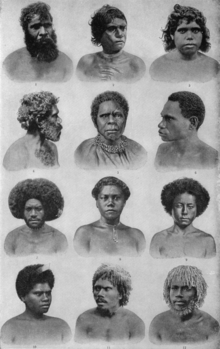| Revision as of 05:21, 12 October 2008 editDelldot (talk | contribs)Administrators47,018 edits clean up, replace deprecated template to fix lk, or rm template if no dorlands entry found, and/or fix/rm broken lk in template using AWB← Previous edit | Revision as of 21:30, 30 November 2008 edit undoRobbot (talk | contribs)94,607 editsm robot Adding: br:Gwareg-abrantNext edit → | ||
| Line 43: | Line 43: | ||
| ] | ] | ||
| ] | |||
| ] | ] | ||
Revision as of 21:30, 30 November 2008
The supraorbital ridge, or brow ridge, refer to a bony ridge located above the eye sockets of all primates. In Homo sapiens sapiens (modern man) the eyebrows are located on their lower margin.
Other terms in use are:
- supraorbital arch
- supraorbital torus
- superciliary ridge
- arcus superciliaris (Latin, meaning "superciliary arch")
- supraorbital margin and the margin of the orbit
Anthropological concept


The size of these ridges varies also between different species of Primate, either living or fossil. The closest living relatives of man, the Great Apes, have relatively pronounced supraorbital ridges, while in modern humans it is relatively reduced. The fossil record indicates that the supraorbital ridge in early homo was reduced as the cranial vault grew and became positioned vertically, above the face.
Some paleoanthropologists distinguish between torus and ridge. In anatomy, a torus is a projecting shelf of bone. Fossil hominids, in this theory, have the torus, but modern humans only have the ridge.
Purpose
The brow ridge is a thick piece of bone on top of the eyes. Its purpose is to reinforce the weaker bones of the face in much the same way that the chin of modern humans was developed to reinforce their comparatively thin mandibles. This was necessary in pongids and early hominids because of the tremendous strain put on the cranium by their tremendous chewing apparatuses, which is best demonstrated by any of the members of the genus Paranthropus. The brow ridge was one of the last traits to be lost in the path to modern humans, and only disappeared with the development of the modern pronounced frontal lobe. This is one of the most salient differences between Homo sapiens sapiens and Homo sapiens neanderthalensis The name for this theory is the Bio-mechanical model for brow ridge formation.

Myths
The folk-myth that the size of the ridges is a mark of the degree of development of rationality has no basis in fact. There is no link between the size of the ridges and any other anatomical trait, including intelligence, in modern humans.
In modern humans
Forensic anthropologist Caroline Wilkenson says that Australoids have the largest brow ridges "with moderate to large supraorbital arches". Caucasoids have the second largest brow ridges with "moderate supraorbital ridges". Negroids have the third largest brow ridges with an "undulating supraorbital ridge". Mongoloids are "absent browridges", so they have the smallest brow ridges.
See also
References
| This article needs additional citations for verification. Please help improve this article by adding citations to reliable sources. Unsourced material may be challenged and removed. Find sources: "Brow ridge" – news · newspapers · books · scholar · JSTOR (September 2008) (Learn how and when to remove this message) |
- For some basic English definitions refer to the American Heritage Dictionary online under supraorbital and torus. Webster's Third New International Dictionary also does not make the distinction.
- ^ Wilkenson, Caroline. Forensic Facial Reconstruction. Cambridge University Press. 2004. ISBN 0521820030
External links
- The Frontal Bone, California State University at Chico site.
- ARCUS SUPERCILIARIS, Webster's Online Dictionary.